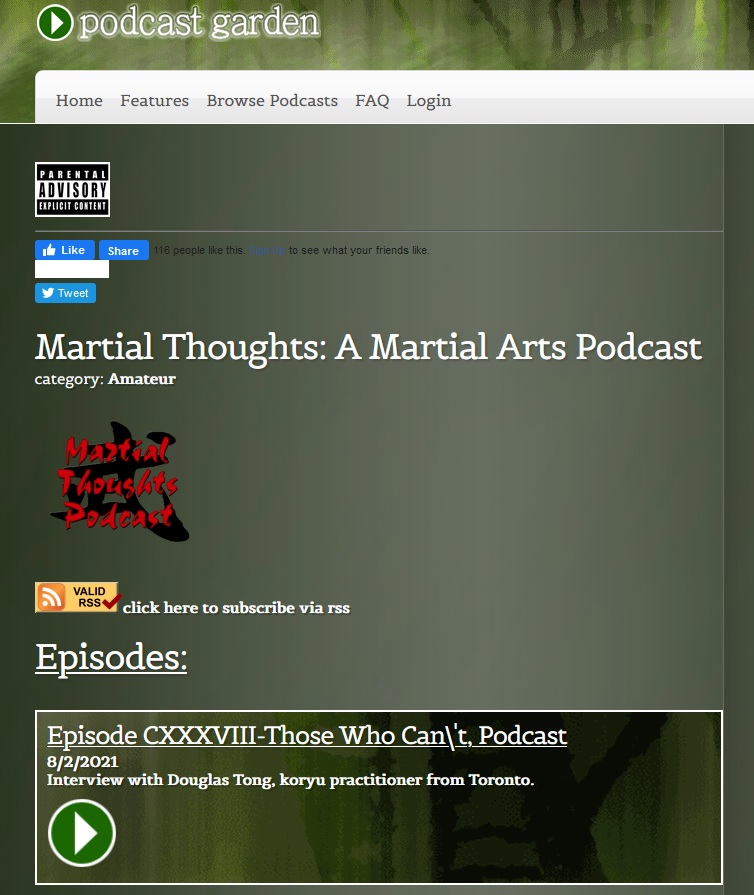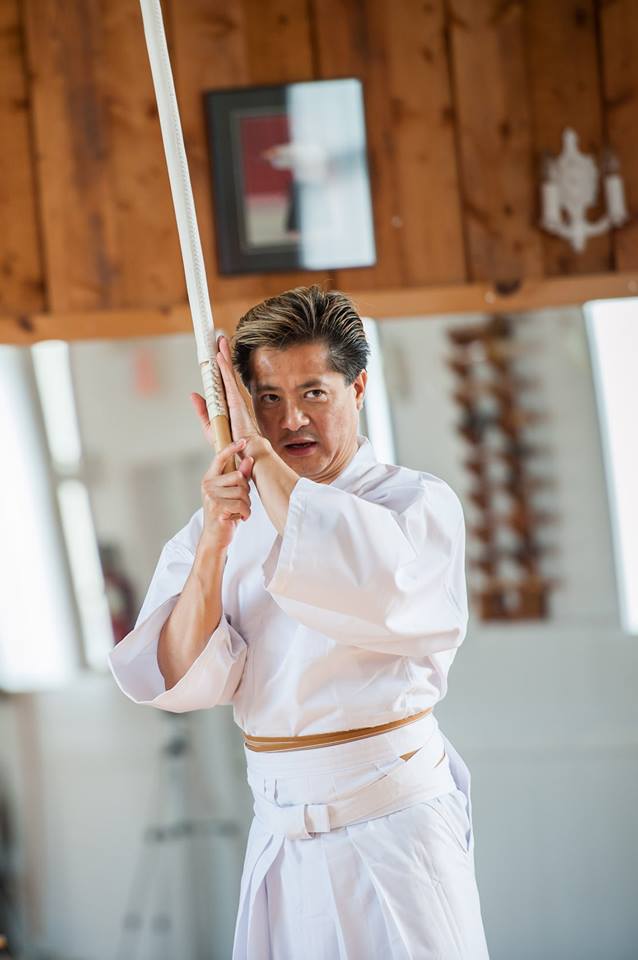
Our founder is Mr. Douglas Tong. He has been teaching kenjutsu (classical Japanese swordsmanship) since his return to Canada in 1994.
__________________________________________________
Experience and Education
Mr. Tong lived in Japan for many years and studied Japanese swordsmanship exclusively under some of the great sword masters:
- Katori Shinto Ryu under the late Master Yoshio Sugino in Kawasaki-shi
Mr. Tong learned the legendary style Katori Shinto Ryu (the Way of the War God of Katori) under the direct tutelage of the acclaimed Master Yoshio Sugino, who was the swordfight choreographer for Director Akira Kurosawa’s two most famous samurai films, Seven Samurai and Yojimbo. Mr. Tong was one of Yoshio Sugino Sensei’s last direct pupils.
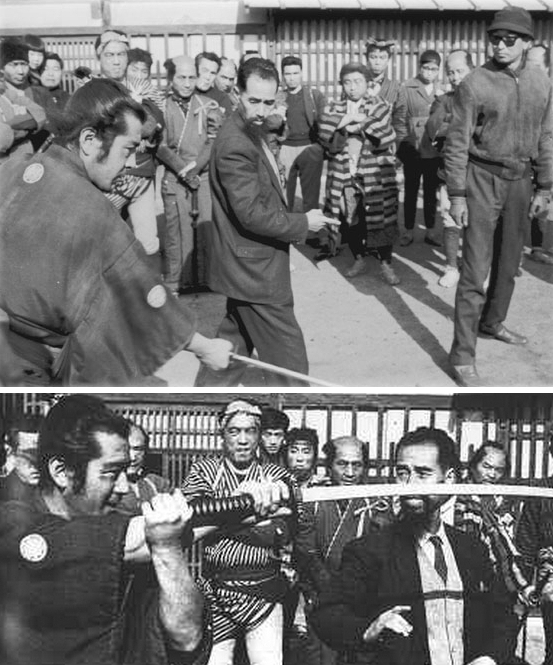 Sugino Yoshio Sensei choreographing a fight scene on the set of Yojimbo with famed actor Mifune Toshiro and legendary director Akira Kurosawa (in hat and glasses)
Sugino Yoshio Sensei choreographing a fight scene on the set of Yojimbo with famed actor Mifune Toshiro and legendary director Akira Kurosawa (in hat and glasses)
Katori Shinto Ryu is one of the oldest styles of Japanese swordsmanship and was created during the Warring States Period (c. 1450), a dark time of civil war marked by incessant fighting. Mr. Tong’s former students, Dennis Wiens and Corey Reid, are ranked practitioners of Sugino-style Katori Shinto Ryu under the current headmaster and run their own dojos in Southern Ontario.
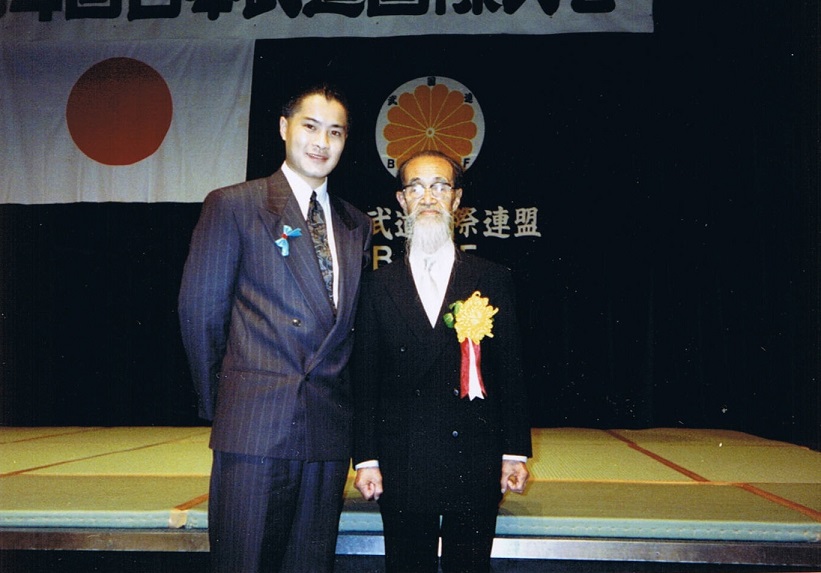 Mr. Tong with Sugino Yoshio Sensei at an IFNB demonstration (Kawasaki 1991)
Mr. Tong with Sugino Yoshio Sensei at an IFNB demonstration (Kawasaki 1991)
- Ono-ha Ittō Ryu under the late Master Takemi Sasamori in Setagaya-ku, Tokyo
Mr. Tong studied the style of Ono-ha Ittō Ryu (the famous One-Sword style) under the direct instruction of Master Takemi Sasamori (the 17th generation Headmaster) and his son-in-law at Reigakudo for a few years. The Ono-ha Ittō Ryu style of swordsmanship gained fame and prominence throughout Japan when its headmaster Ono Tadaaki was appointed the swordsmanship instructor to the second Tokugawa shogun, Tokugawa Hidetada. Ono-ha Ittō Ryū became an official kenjutsu school of the Tokugawa shogunate. Modern kendo grew out of Ittō Ryu and many of the techniques used and principles observed in kendo derive from this style. It is not surprising that in Japan, many senior kendo practitioners also study Ittō Ryu. Master Sasamori’s generosity allowed Mr. Tong the unique opportunity to study this renowned style through private one-on-one lessons with only the teacher and himself and developed in him a great appreciation for the beauty of this art.
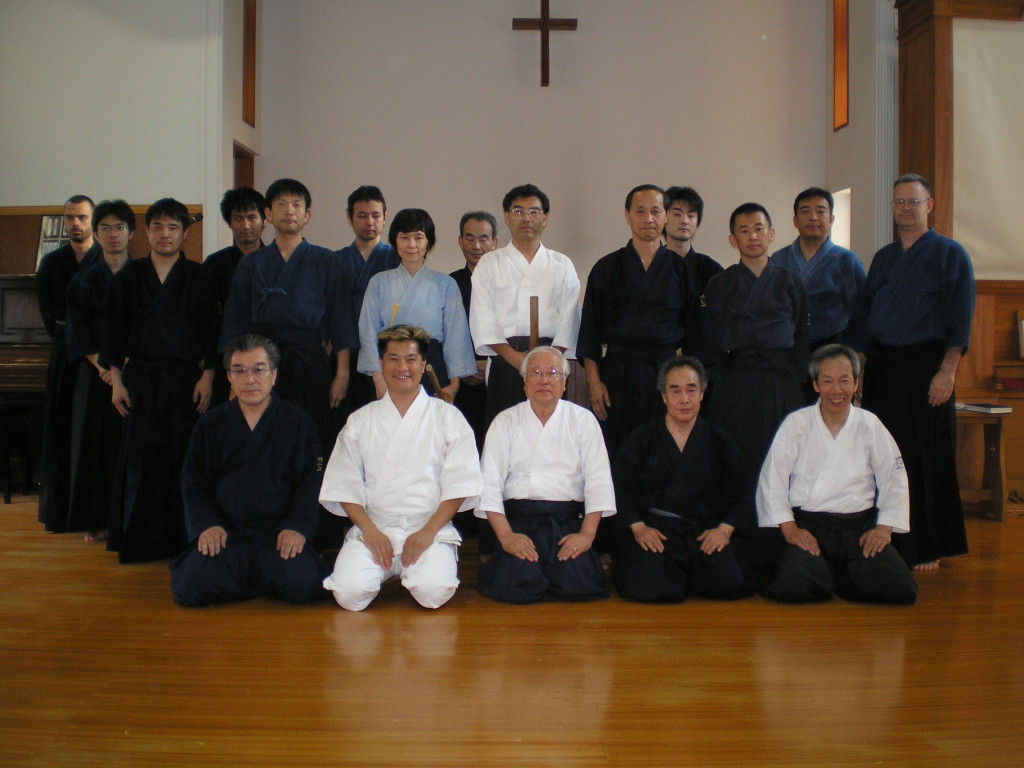 Mr. Tong with Sasamori Sensei and members of Reigakudo (Tokyo 2008)
Mr. Tong with Sasamori Sensei and members of Reigakudo (Tokyo 2008)
- Muso Shinden Eishin Ryu under Master Toshihiko Izawa in Fujisawa-shi
Mr. Tong studied the beautiful art of Muso Shinden Eishin Ryu iaido as a direct student of Master Toshihiko Izawa (7th dan kendo, 7th dan iaido). Iaido is a sword art that emphasizes being aware and capable of quickly drawing the sword and responding to a sudden attack. Because it is associated with the smooth, controlled movements of drawing the sword, cutting the opponent down, and then replacing the sword in the scabbard, iaido has been coined “the art of the draw and cut”. Mr. Tong has a nidan (2nd degree black belt) in iaido. He was tested at the Kanagawa Prefectural Gradings in Yokohama. Being fortunate to be a member of a small class of only 4 students, Mr. Tong received very personalized instruction for many years directly from Izawa Sensei.
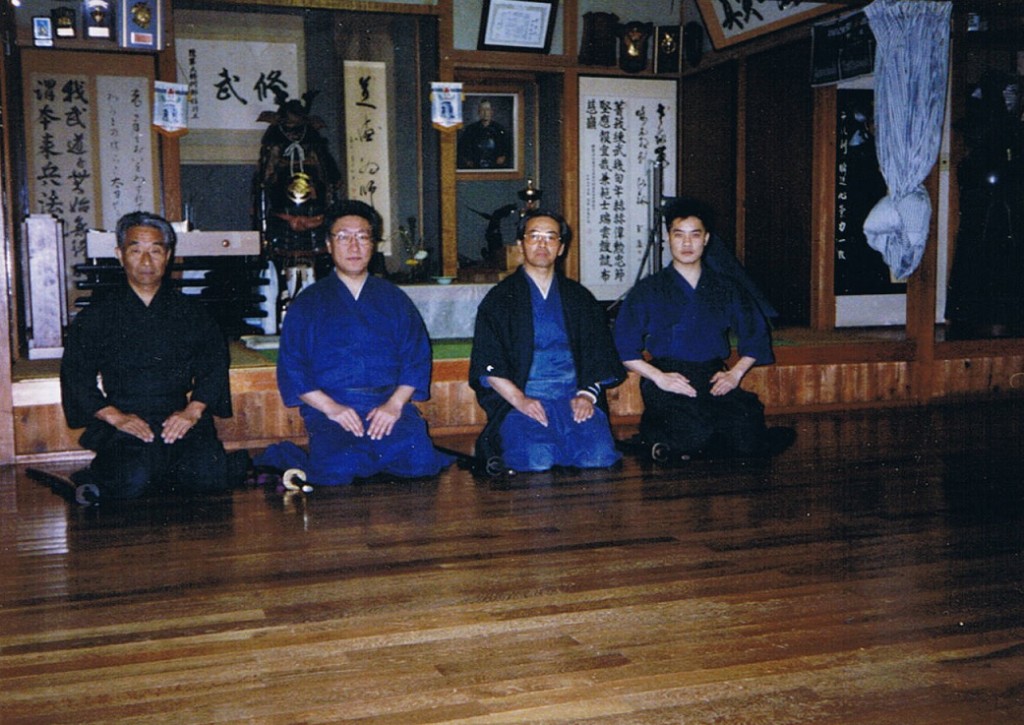 Mr. Tong with Izawa Sensei (2nd from the right) (Fujisawa 1992)
Mr. Tong with Izawa Sensei (2nd from the right) (Fujisawa 1992)
- Yagyu Shinkage Ryu under the late Master Masao Mutoh in Zushi-shi
Mr. Tong began his study of Yagyu Shinkage Ryu (the New Shadow style of the Yagyu) under the late Master Masao Mutoh, the 10th soke of Yagyu Shingan Ryu Taijutsu (Edo-Line) and 2nd shihan of the Ohtsubo Branch of Yagyu Shinkage Ryu. Yagyu Shinkage Ryu is famous as the Shogun’s style. It is also famous as the first style to fuse Zen Buddhism with swordsmanship, transforming a killing sword into a “life-giving sword”, a sword of peace. Through his kindness, Mr. Tong was allowed the rare chance to study and research this most unique and prestigious of Japanese sword styles.
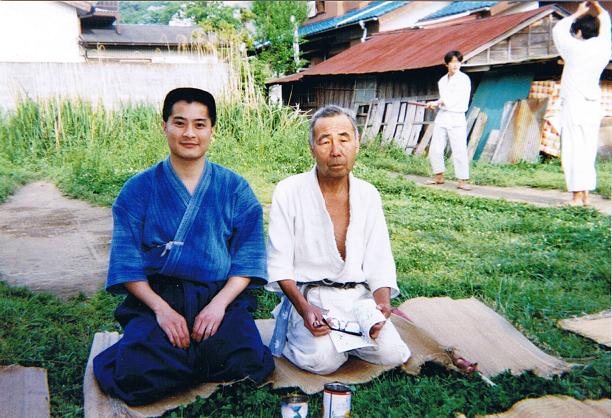
Mr. Tong with Mutoh Sensei (Zushi 1993)
- Yagyu Shinkage Ryu under Master Yasushi Kajitsuka in Tochigi
Mr. Tong now continues his studies under Mutoh Sensei’s successor, Master Yasushi Kajitsuka, the 11th soke of Yagyu Shingan Ryu Taijutsu (Edo-Line) and 3rd shihan of the Ohtsubo Branch of Yagyu Shinkage Ryu. Mr. Tong is the leader of the official study group (keiko-kai) for the Ohtsubo Branch in Canada under Master Kajitsuka.
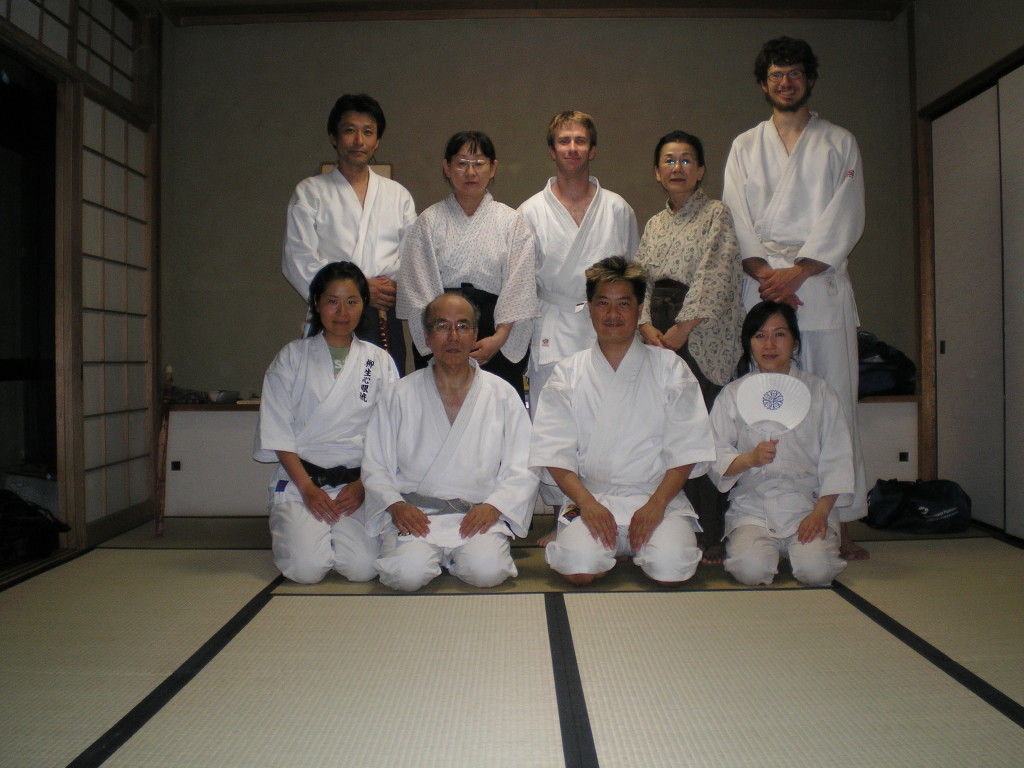 Mr. Tong with Kajitsuka Sensei and members of Arakido (Tokyo 2008)
Mr. Tong with Kajitsuka Sensei and members of Arakido (Tokyo 2008)
__________________________________________________
Skill Set, Knowledge Base, and Approach
Like his teachers before him, Mr. Tong continues to train and study, to deepen his understanding of the Way of the Sword. From his apprenticeship in Japan and over 30 years of study and research both in Japan and in Canada, Mr. Tong brings a comprehensive and authoritative knowledge of the ancient art of classical Japanese sword fighting.
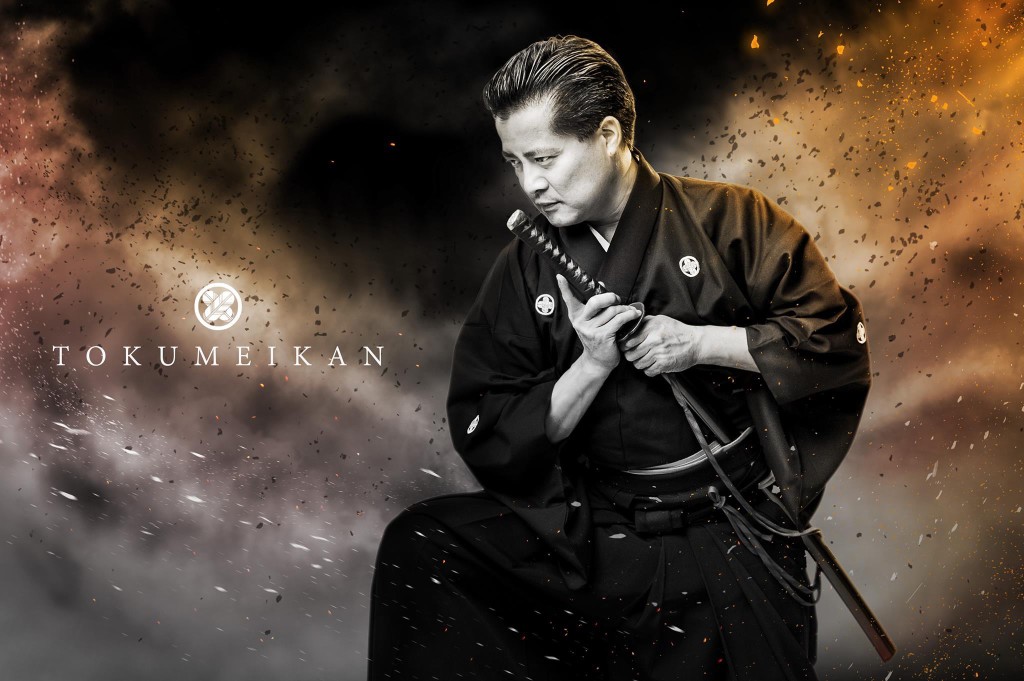
Whether it is battlefield fighting (Katori Shinto Ryu) or one-on-one dueling (Yagyu Shinkage Ryu, Ono-ha Itto Ryu, kendo) or the art of drawing and cutting (Muso Shinden Eishin Ryu), Mr. Tong has studied them all with passion. In his studies of these very different arts and their distinct mindsets, in his apprenticeship with some of the greatest teachers, and his immersion in these most famous and ancient of Japanese sword traditions, it has developed in him a very unique and uncommon skill set and has given him a very rare understanding of Japanese swordsmanship in all its forms.
A life-long learner, Mr. Tong is ever enthusiastic in wanting to learn more and more about kenjutsu. In his words:
“Kenjutsu (Japanese sword-fighting) is endlessly fascinating. Whether you are fighting with two swords, have only a short sword, fighting against a naginata or a spear, dueling sword versus sword, or even trying to survive when you have only your bare hands against an opponent wielding a sword (“muto” – the famous theory of No-Sword), there is always something to learn: about the weapon, the tactics, the psychological mindset, the style’s particular approach, or even about yourself. These moments of realization, these sudden epiphanies. That is the real beauty of the art.”
__________________________________________________
Public Visibility
Mr. Tong is regularly featured in the media. He was interviewed by the CBC, Canada’s national network, in a gorgeous documentary on high-level but little-known martial arts teachers teaching reclusively somewhere in the Greater Toronto Metropolitan Area. Please watch it. It is a beautiful interview.
Tong Sensei has been featured in numerous interviews in print magazines and newspapers. You can read them on our Media page.
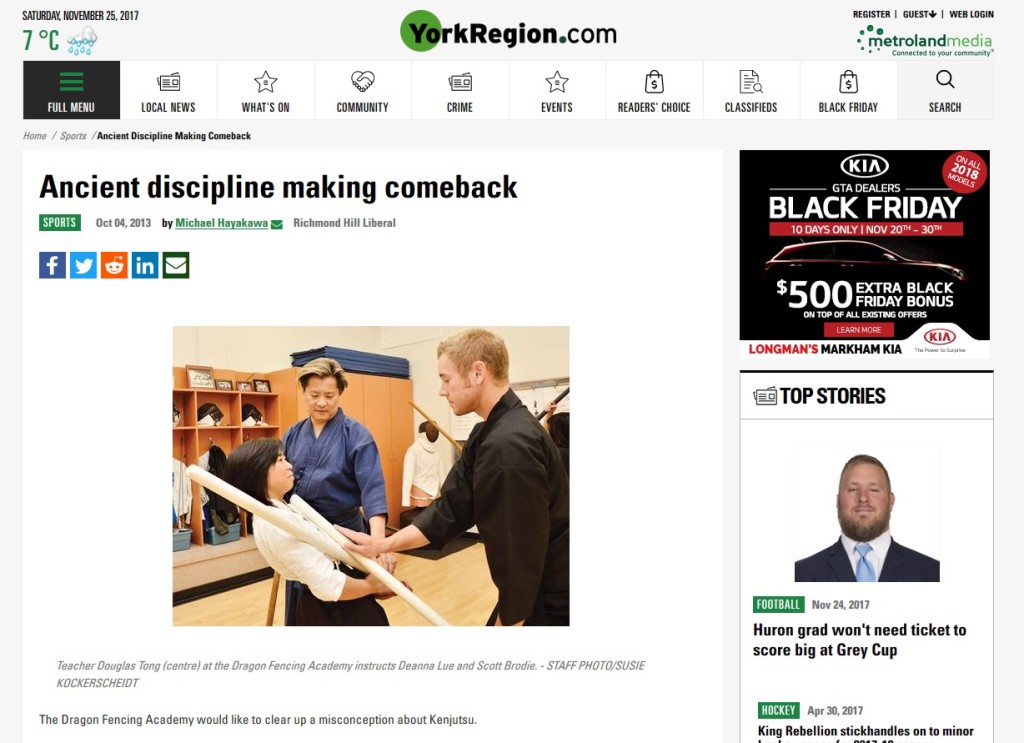 The online version of the interview with Tong Sensei in the Richmond Hill Liberal
The online version of the interview with Tong Sensei in the Richmond Hill Liberal
He has been featured on live television shows, as well as TV documentaries. You can find them on our Media page.
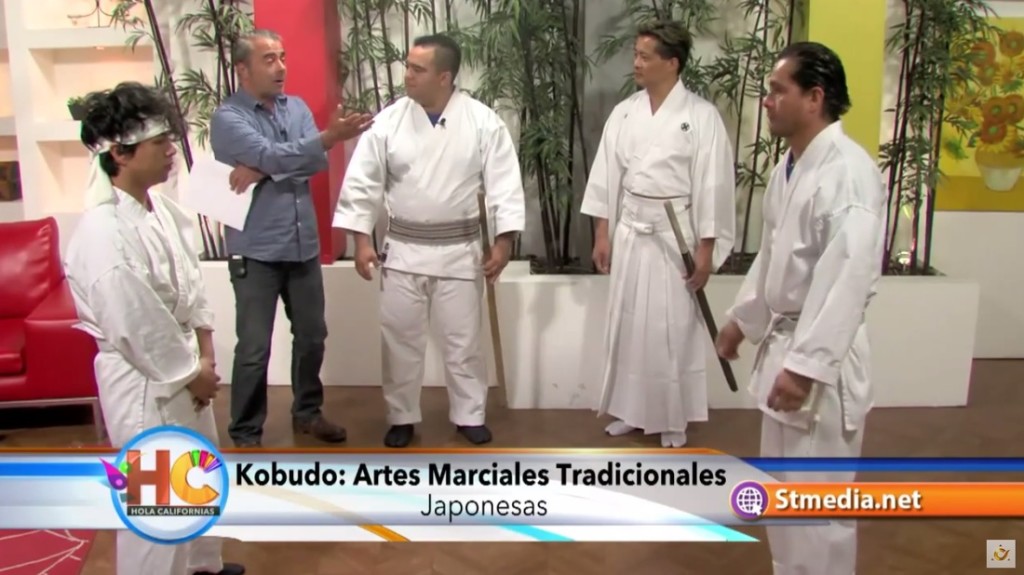 Tong Sensei featured on Hola Californias, a morning show shown in the Tijuana – San Diego Metropolitan Area
Tong Sensei featured on Hola Californias, a morning show shown in the Tijuana – San Diego Metropolitan Area
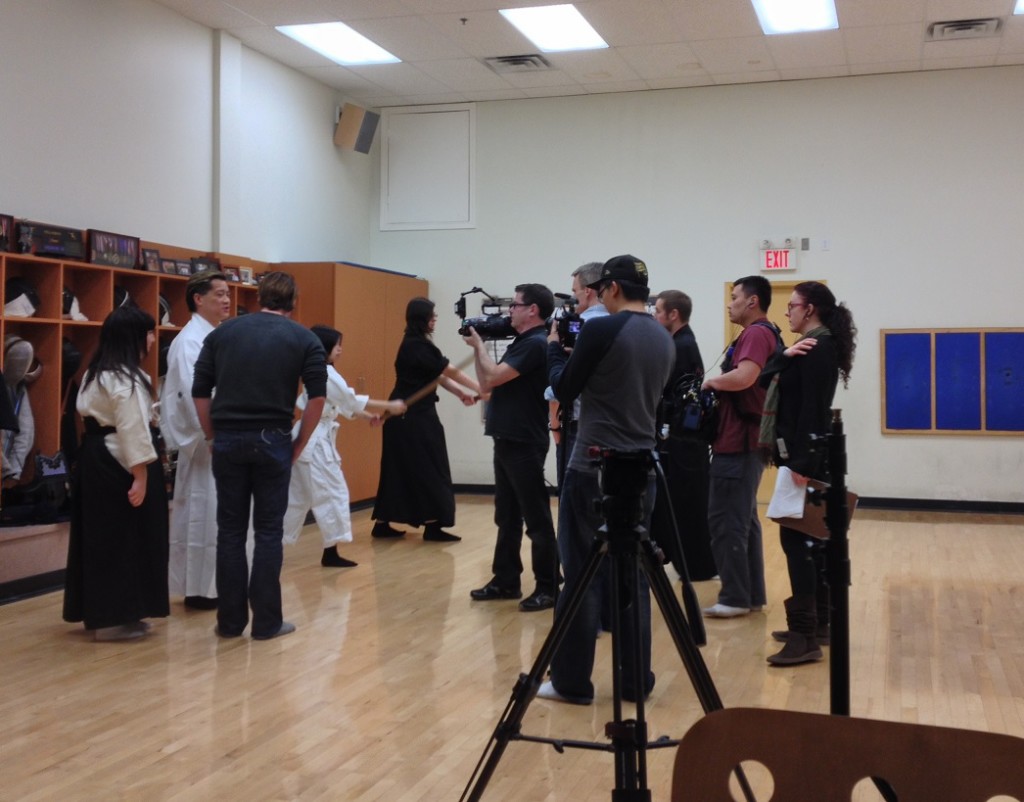 Tong Sensei interviewed on the acclaimed documentary series Oh My God!
Tong Sensei interviewed on the acclaimed documentary series Oh My God!
And even on promotional and publicity shots.
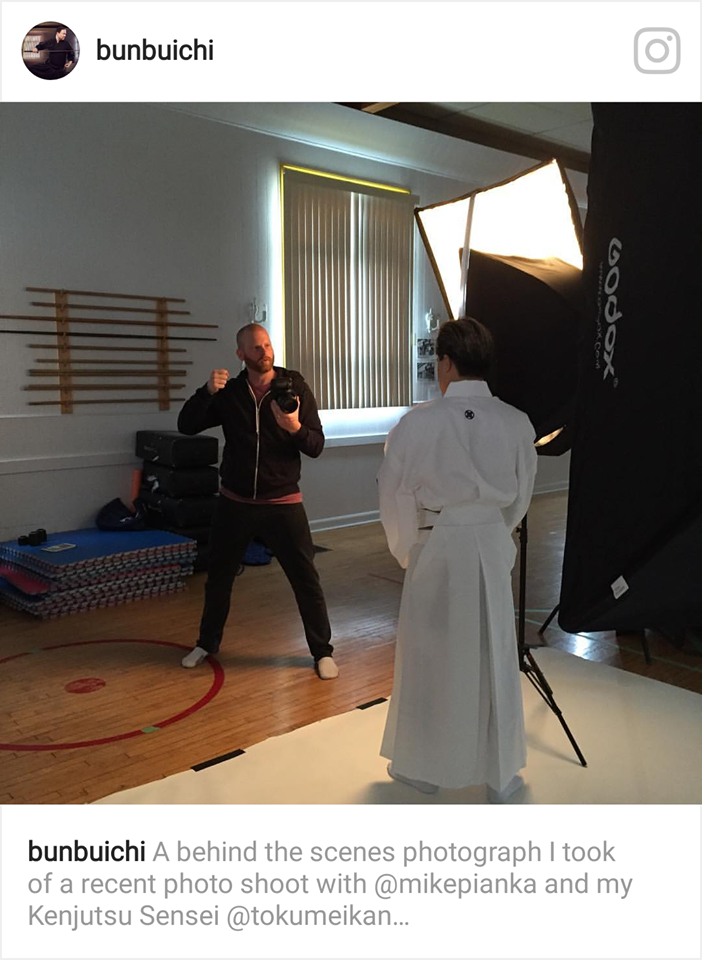 The photographer Mike Pianka has a great vision. He has a certain look he’s after and he communicates that to Tong Sensei.
The photographer Mike Pianka has a great vision. He has a certain look he’s after and he communicates that to Tong Sensei.
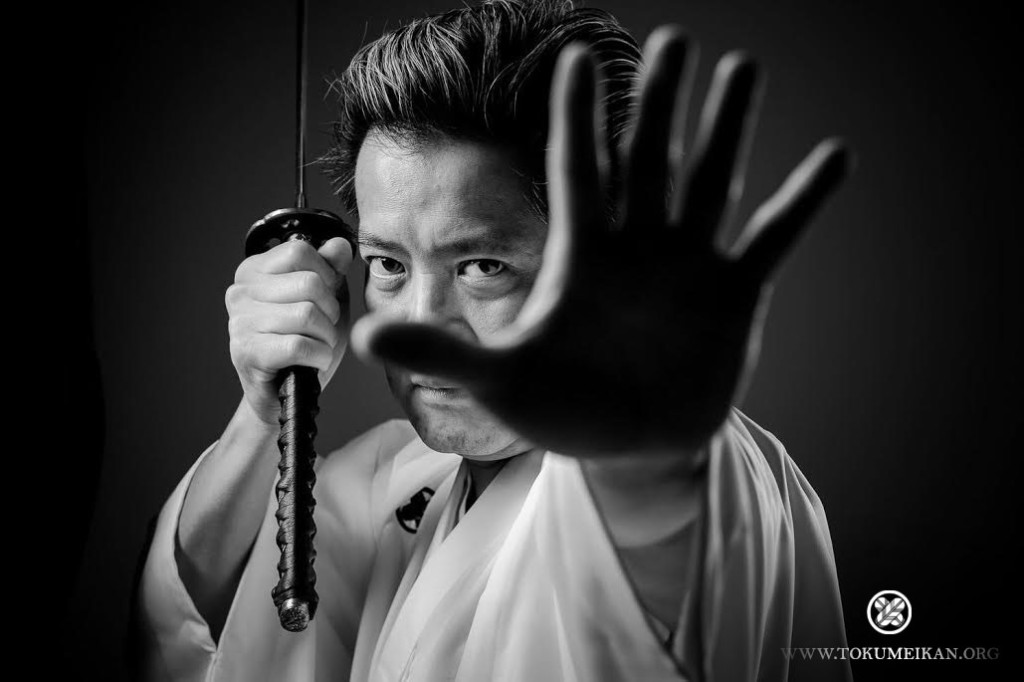 And this is the final product. A quietly powerful image.
And this is the final product. A quietly powerful image.
—————————————————————————
Tong Sensei was featured in a series of podcasts done by Patrick Suen Sensei, Director of Tokushikai Canada, one of the high-level iaido dojos in Canada.
Inside Look Podcast – A Conversation with Douglas Tong Sensei, Part 1: “In this stimulating conversation, we talk about the role of Japanese culture in martial arts, and the complexities and challenges for students of understanding and abiding by these traditions”.
Inside Look Podcast – A Conversation with Douglas Tong Sensei, Part 2: “Part 2 of this series will focus on the concept of rank, and where it fits within Japanese martial arts, and the broader society. In this stimulating lecture, Tong Sensei shares insights from his Sensei as well as personal experience and knowledge from a lifetime in education, including a graduate degree and a career that spans decades”.
Special Episode – An In-Depth Look at the Roles of a Teacher with Douglas Tong: “The goal of the “In-Depth Look” series is to explore subjects adjacent to our budo practice — examining the relevance, efficacy, and methods of incorporating these work and life experiences into budo practice, budo teaching, and community building. In this episode with Douglas Tong, we explore the unique roles of a teacher.”
Please watch them. They are very interesting interviews.
Tong Sensei has also been interviewed on audio podcasts as well. Here is one (click on photo below):
—————————————————————————
Tong Sensei’s stories have also been featured on social media on various Facebook and Instagram pages specializing in budo.
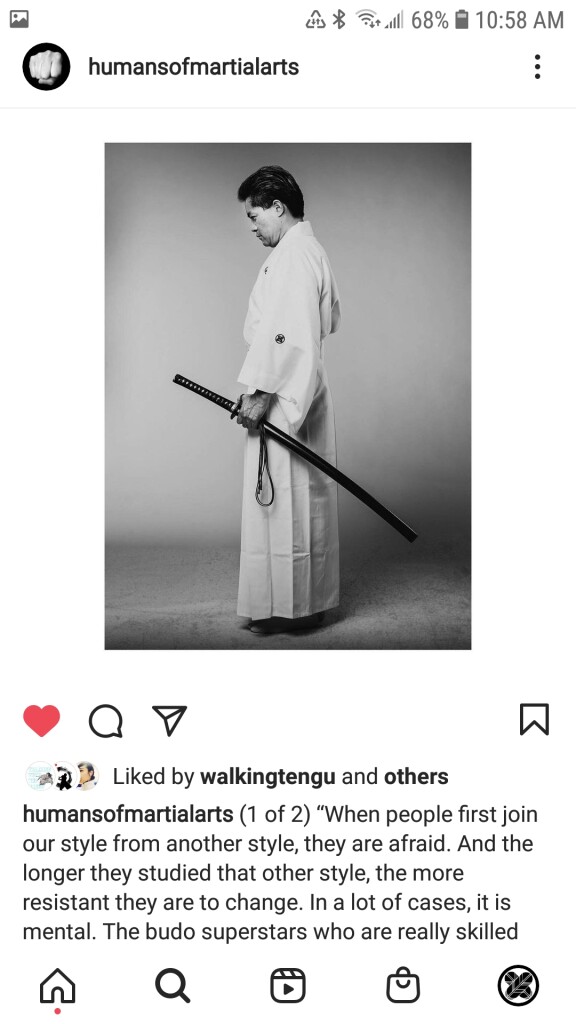
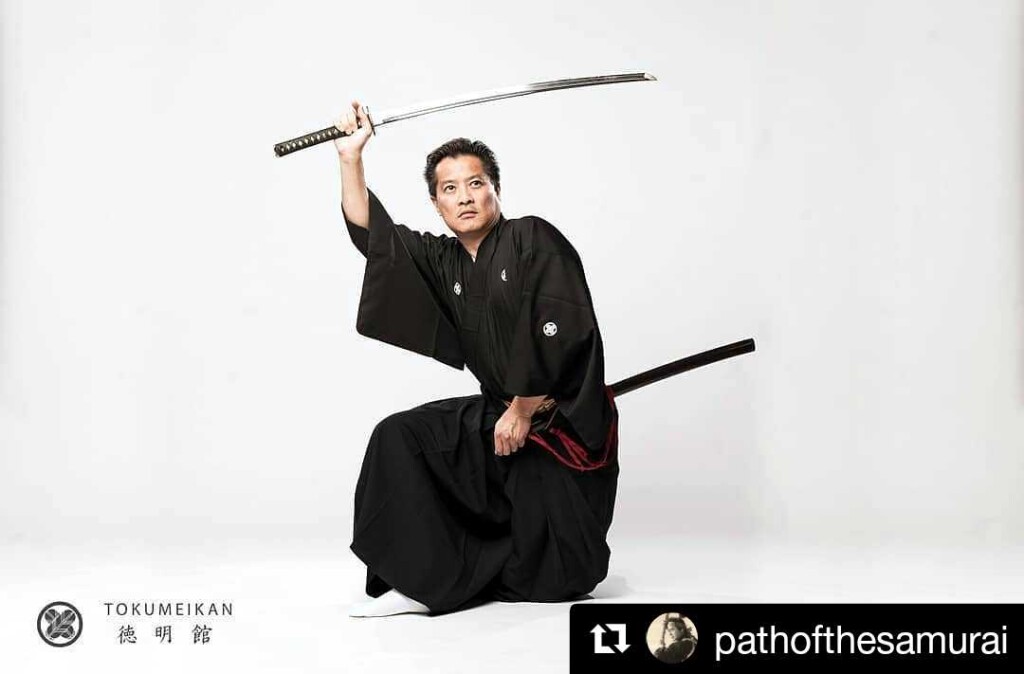
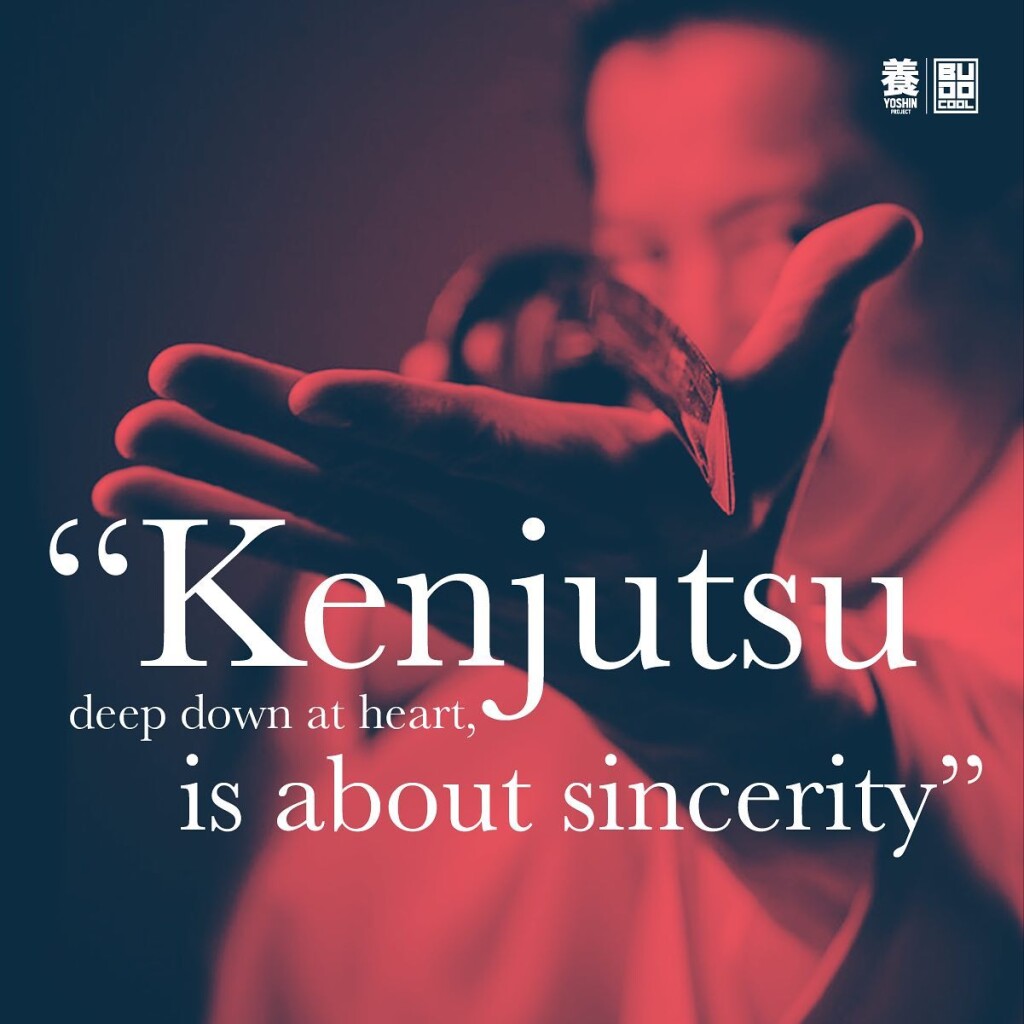
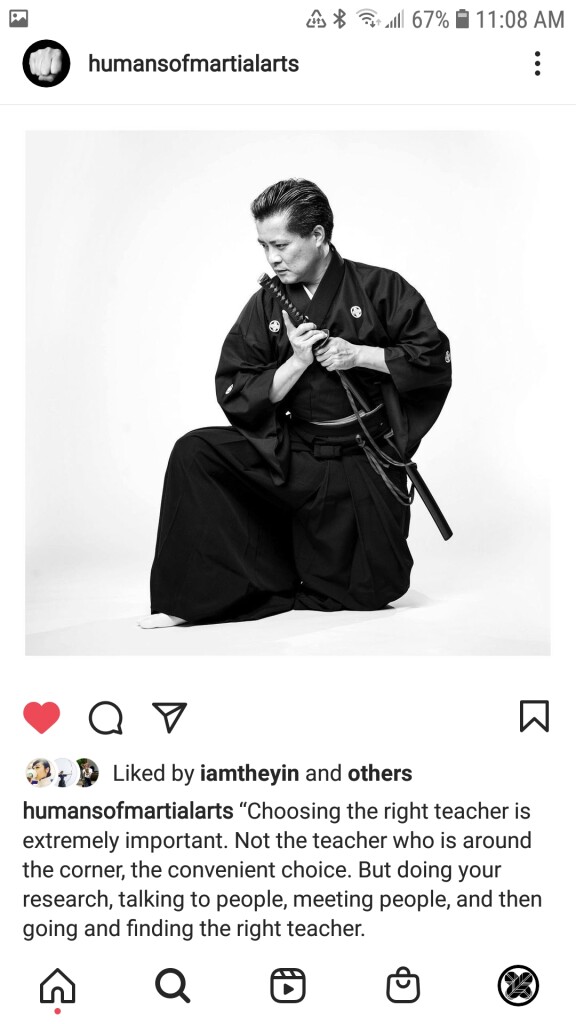
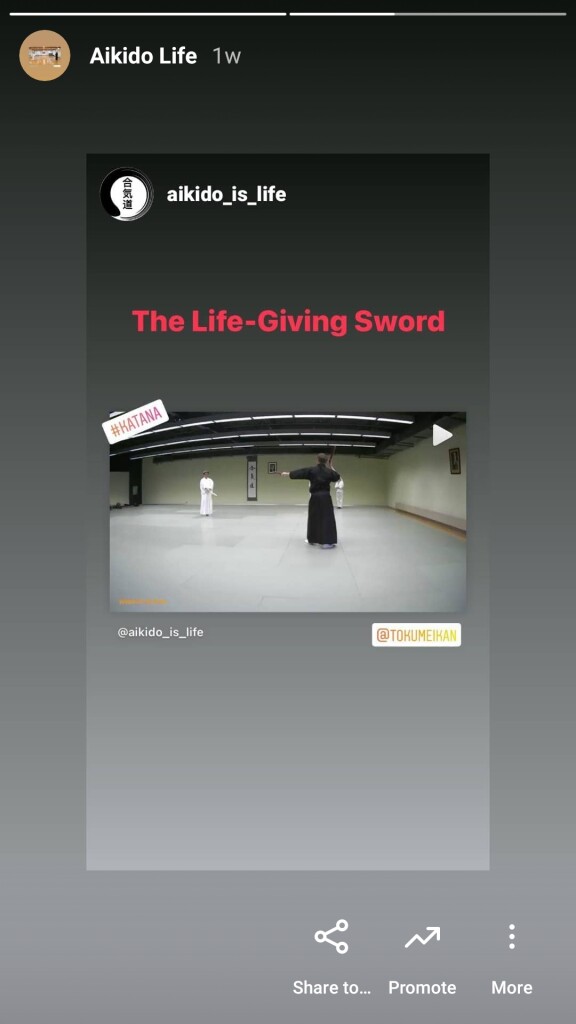
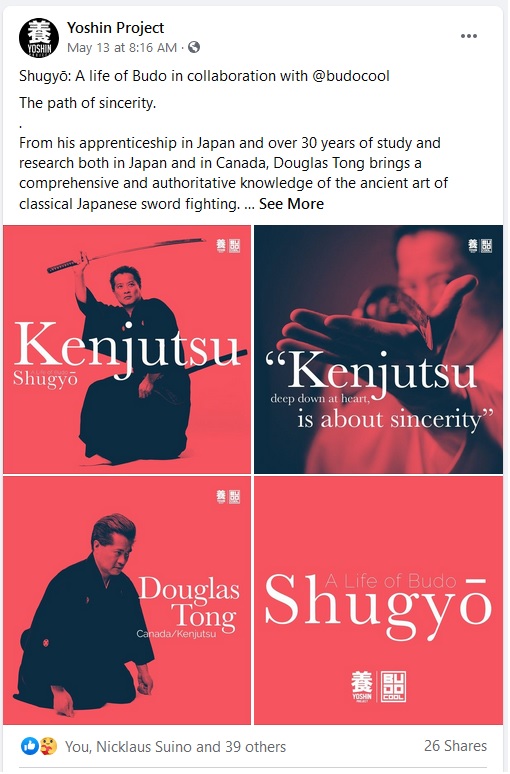
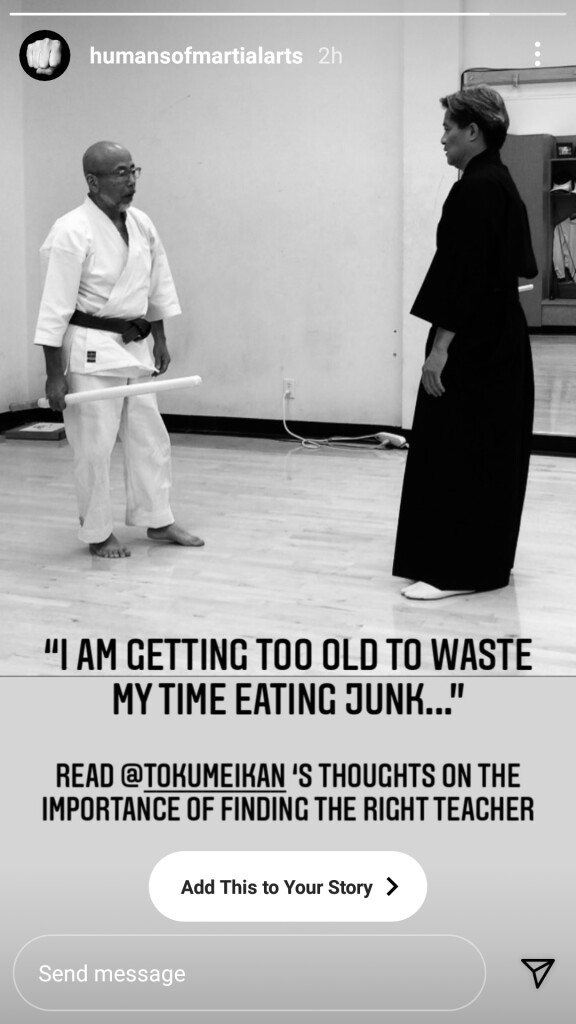
__________________________________________________
Leadership
In terms of being actively involved in the community, Mr. Tong teaches classes and conducts seminars in kenjutsu at various dojos in the Greater Toronto Area (GTA). He also runs workshops at martial arts expos like MMA Expo and at fan conventions such as Anime North, and he runs special programs in Japanese swordsmanship for organizations such as Rapier Wit Stage Combat School.
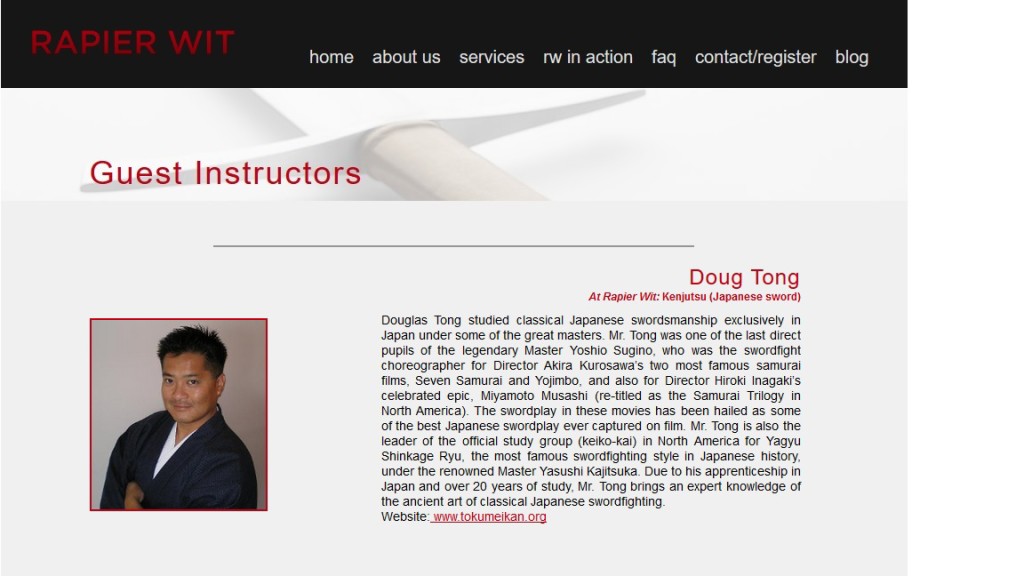 Tong Sensei’s bio on Rapier Wit’s website
Tong Sensei’s bio on Rapier Wit’s website
Mr. Tong is also involved with the Japanese community in Toronto, serving for years as one of the assistant kendo instructors at the Nikka Gakuen Kendo Club, as well as volunteering and helping out at the Nikka Gakuen Japanese School.
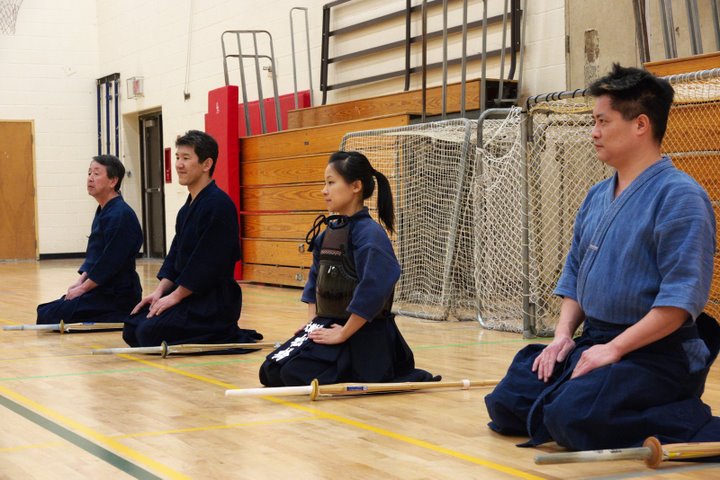 Kendo instructors at the Nikka Gakuen Kendo Club in Toronto. From left to right: Hamaba Sensei (JCCC), Sumi Sensei (JCCC), Matsuhashi Sensei, Tong Sensei.
Kendo instructors at the Nikka Gakuen Kendo Club in Toronto. From left to right: Hamaba Sensei (JCCC), Sumi Sensei (JCCC), Matsuhashi Sensei, Tong Sensei.
Mr. Tong is the leader of Tokumeikan, an organization with affiliated dojos throughout North America. Mr. Tong thus manages many group leaders and senior students across Canada, the US, and Mexico.
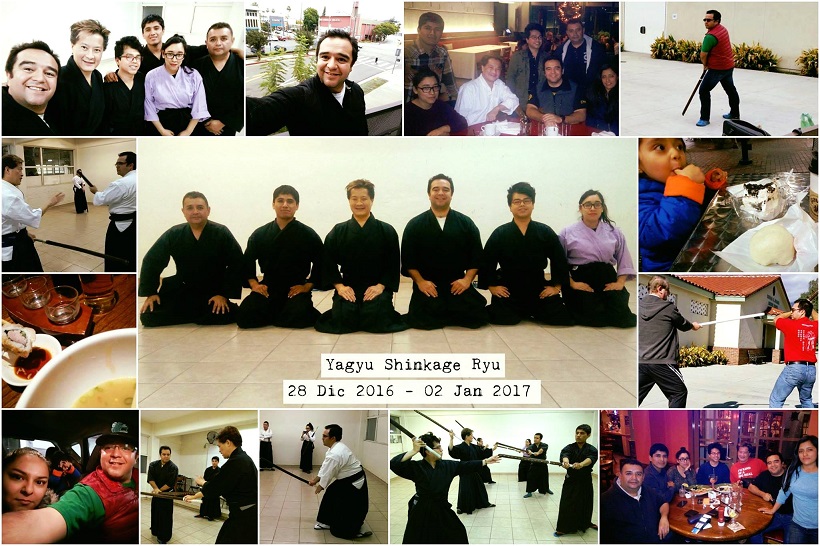 Tong Sensei with with members of Muso Dojo, Tokumeikan’s group in Tijuana, Mexico
Tong Sensei with with members of Muso Dojo, Tokumeikan’s group in Tijuana, Mexico
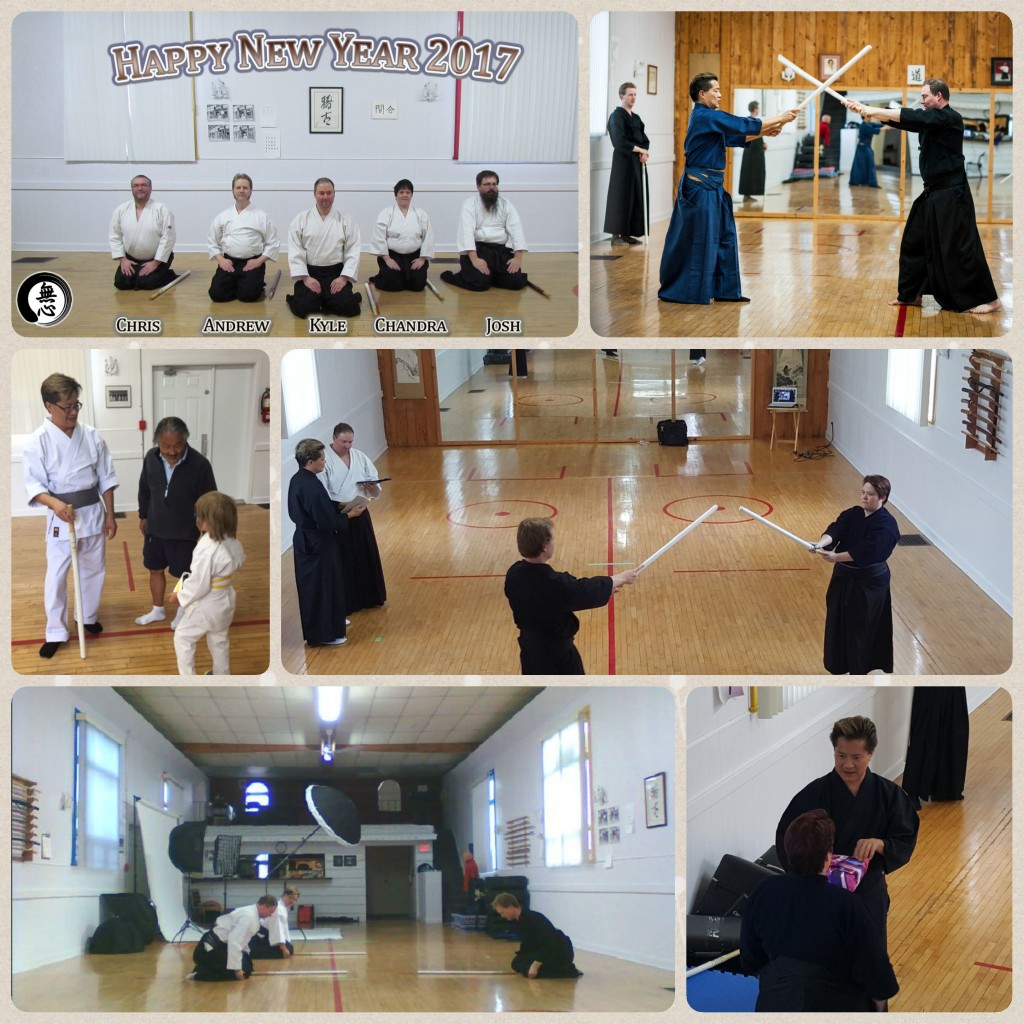 Tong Sensei with members of Mushin Kenjutsu, Tokumeikan’s group in Thunder Bay, Ontario
Tong Sensei with members of Mushin Kenjutsu, Tokumeikan’s group in Thunder Bay, Ontario
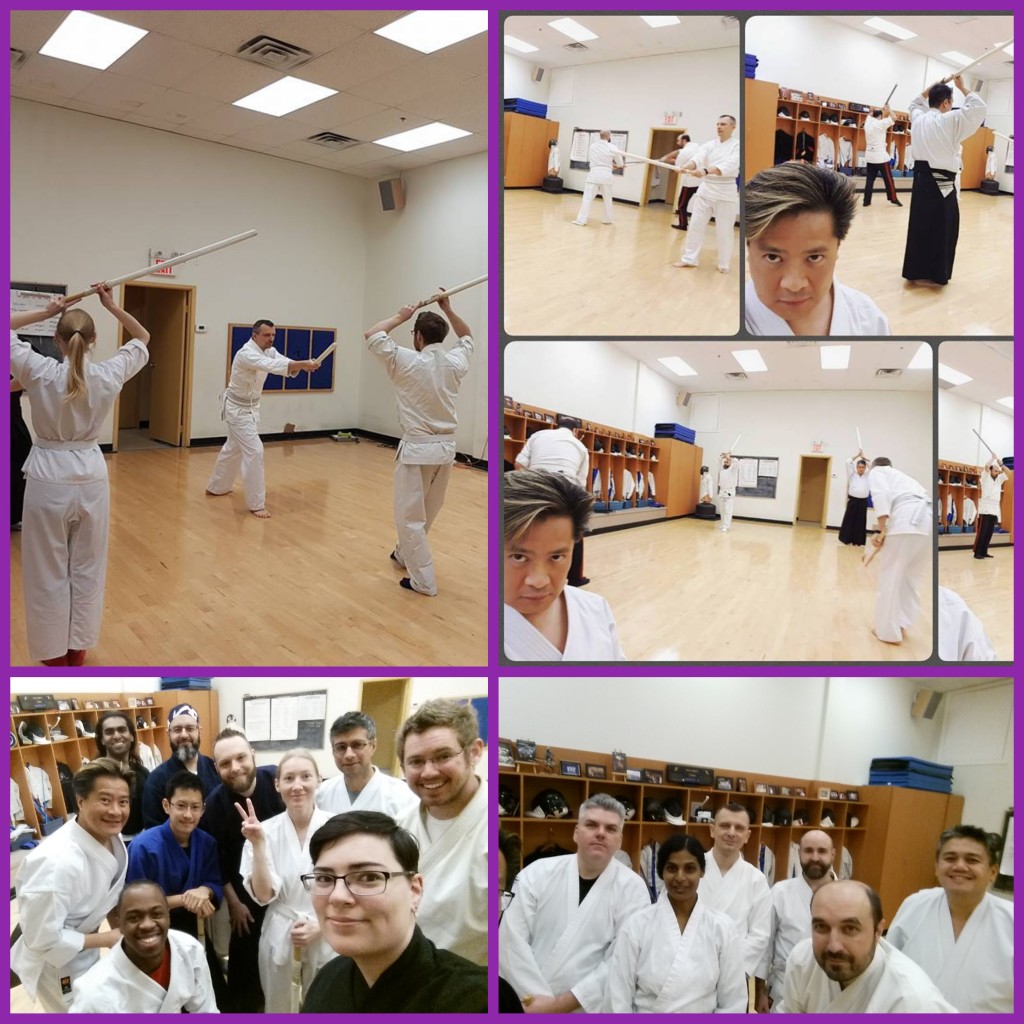 Tong Sensei with members of Dragon Fencing Academy, Tokumeikan’s group in Toronto, Ontario
Tong Sensei with members of Dragon Fencing Academy, Tokumeikan’s group in Toronto, Ontario
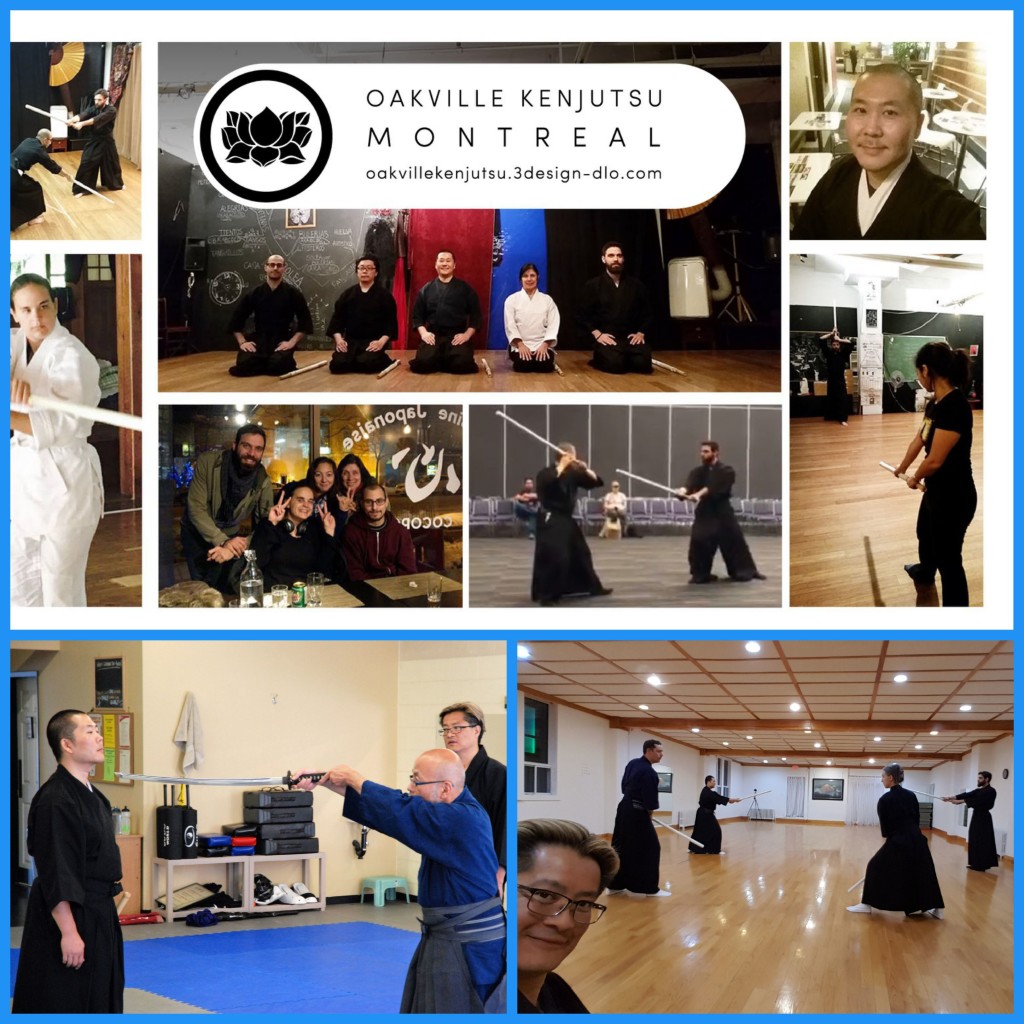 Tong Sensei with members of Oakville Kenjutsu (Montreal), Tokumeikan’s group in Montreal, Quebec
Tong Sensei with members of Oakville Kenjutsu (Montreal), Tokumeikan’s group in Montreal, Quebec
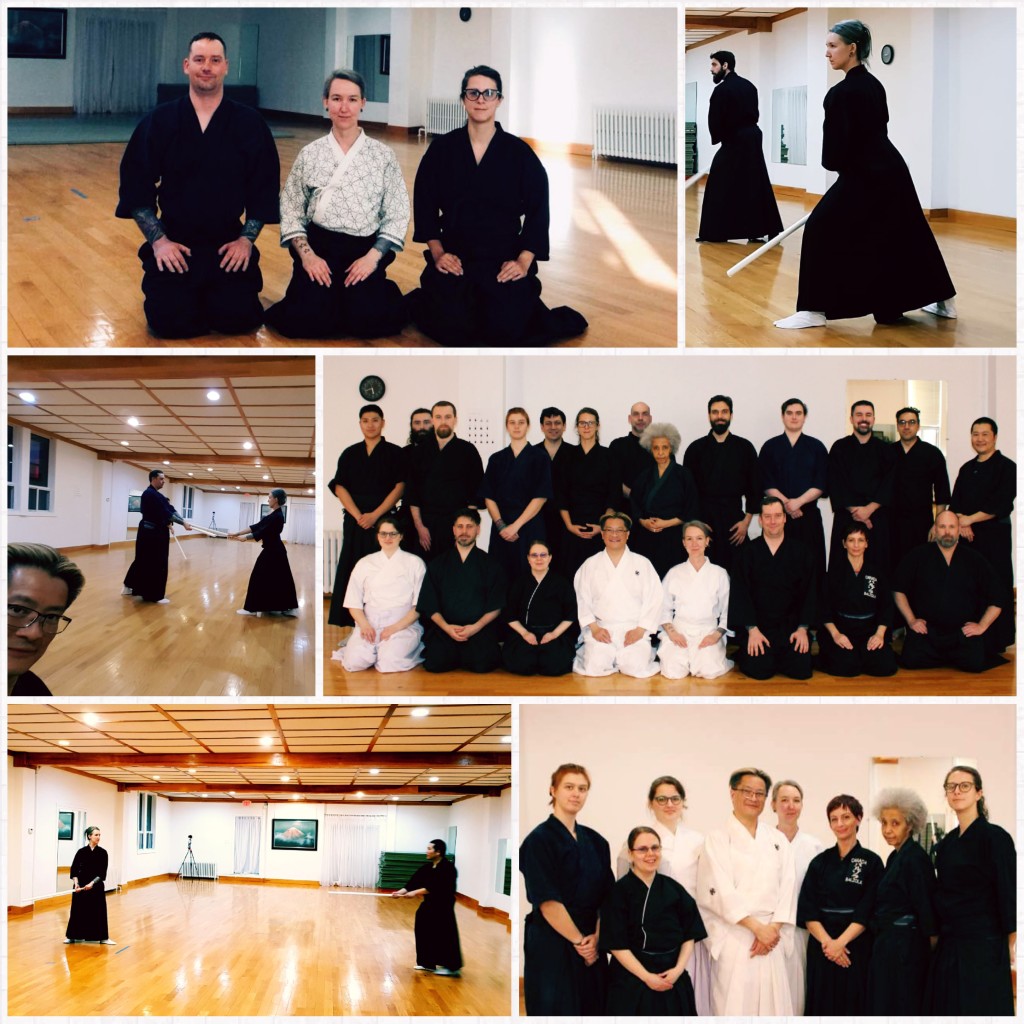 Tong Sensei with members of Meishinkan Kenjutsu, Tokumeikan’s group in Ottawa, Ontario
Tong Sensei with members of Meishinkan Kenjutsu, Tokumeikan’s group in Ottawa, Ontario
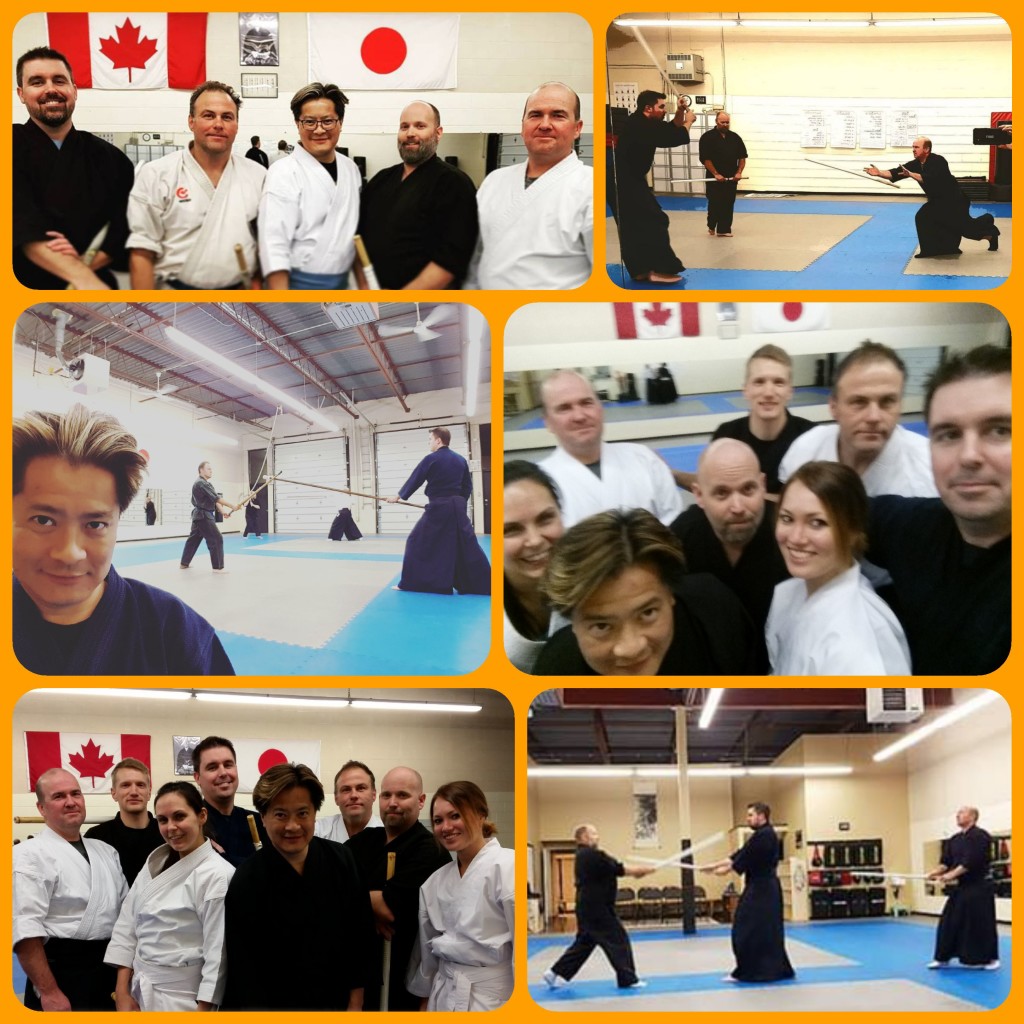 Tong Sensei with members of Headwaters Kenjutsu, Tokumeikan’s group in Orangeville, Ontario
Tong Sensei with members of Headwaters Kenjutsu, Tokumeikan’s group in Orangeville, Ontario
__________________________________________________
Professional Life
In his professional life, Mr. Tong has a Master’s Degree in Education. He taught overseas for many years in Japan. When he returned to Canada, he was employed as a lecturer and course instructor in the Department of Applied Linguistics at Brock University. Offered the opportunity to pursue doctoral studies (Ph.D.) by the Ontario Institute for Studies in Education (OISE) at the University of Toronto, he declined in order to pursue his passion and his true calling: mastering the art of teaching real students in real classrooms and making a real difference in their lives; teaching on the front lines rather than following a more detached life of research and academia. He is currently a public schoolteacher with the Peel District School Board, the second largest school board in Canada. An experienced Master Teacher, Mr. Tong has served for years as an Associate Teacher (mentor) for many Teacher-Candidates (interns), mentoring and instructing young teachers who are just entering the profession.
Mr. Tong is also dedicated to making a difference in the schools that he works in, serving in various administrative committees to do with staffing, culture and climate, and leadership. He is furthermore dedicated to improving the lives of the teachers he works with. Serving as Union Steward at his school, he safeguards the rights of, mediates for, and counsels teachers. Finally, Mr. Tong is a member of the Ontario College of Teachers in good standing.
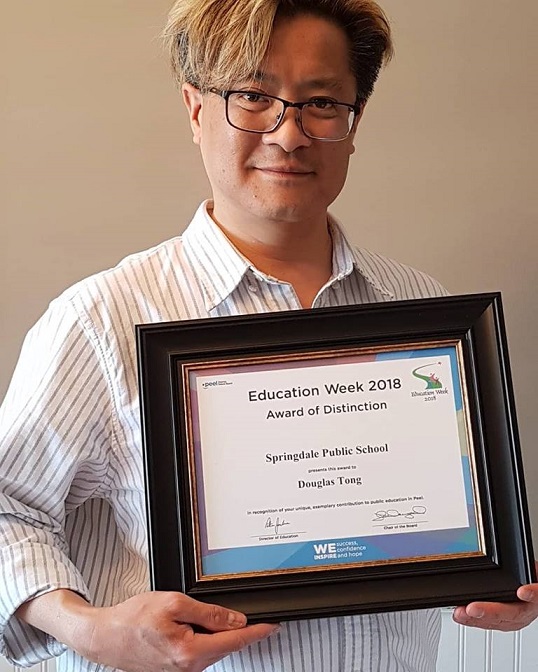 Mr. Tong was deeply honoured and very humbled to be given this award by his fellow teachers and his school.
Mr. Tong was deeply honoured and very humbled to be given this award by his fellow teachers and his school.
Mr. Tong lives with his wife Tazuko and their two sons in the Greater Toronto Area.
__________________________________________________
Impressions
What is Mr. Tong’s favourite quote?
“My favourite quote comes from my master, Kajitsuka Sensei. He said:
“Budo is like climbing a mountain. Everyone is climbing up the same mountain. We are all mountain climbers in the same group. I am just farther up the mountain than you. But, I am not a guide telling you where you should go. I have seen the path that you will take. So, I can point out some of the pitfalls that I have already encountered on my journey up this mountain. However, you must realize that I am still myself going up this mountain…”
That’s humility. And the spirit of budo.”
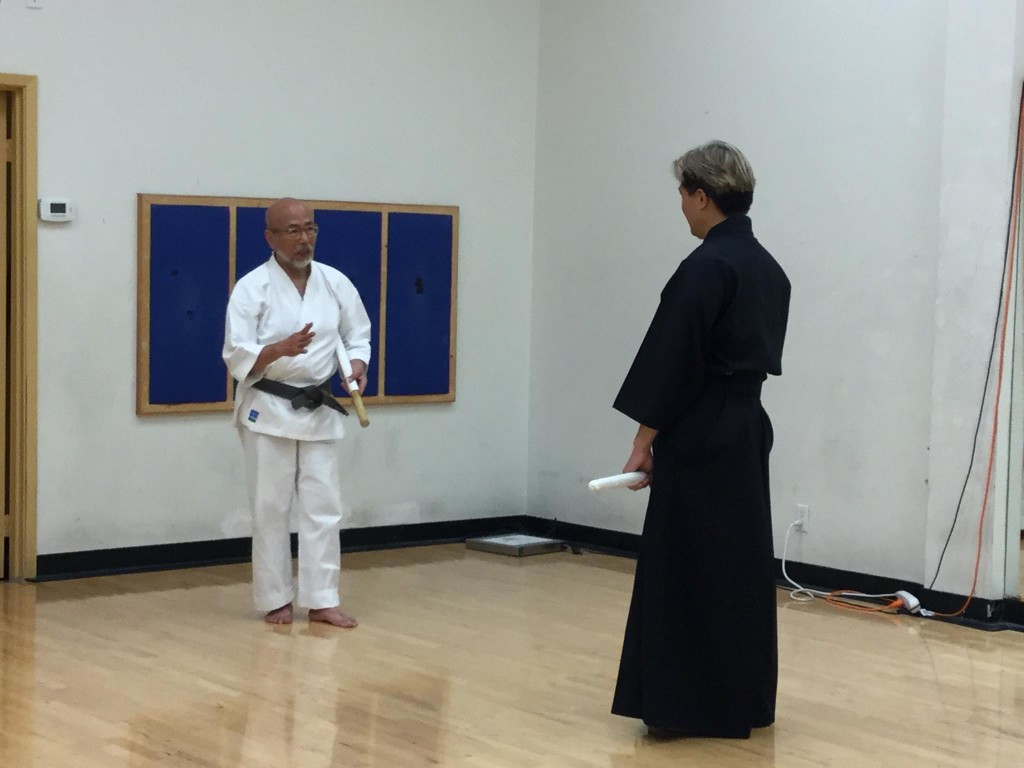 Master and Disciple: Kajitsuka Sensei and Mr. Tong (Toronto 2016)
Master and Disciple: Kajitsuka Sensei and Mr. Tong (Toronto 2016)
__________________________________________________
Recollections
What memory stands out for Mr. Tong from his training days in Japan? It is this story:
“One day in the summer of 1992, as Sunday morning class was ending, a group of the European students was getting undressed on the dojo floor. To give a little background, in the summer months in Japan at Sugino Dojo, there would be foreign visitors from other countries who would come to train for a special session like for a month. Usually they were foreign teachers or senior students, black belts all of them, pretty skilled, and probably pretty highly recognized in their own countries for their achievements in martial arts. And some of them yes would come in with airs and the attitude of being a big shot. They would live at the dojo and sleep at the dojo. On one occasion after Sunday class, as we were all preparing to go for lunch and a beer at the local little restaurant nearby with Yoshio Sugino Sensei, they were all taking their hakama off. When Sugino Sensei reappeared after taking his hakama off in an adjacent room, he still had his aikido uniform on (gi top and pants) and it was tied with a white belt. One of the European black belts, a teacher I presume, asked Sugino Sensei: “Sensei, why do you wear a white belt?” He said it in a joking manner, like he was amused. It was translated through an interpreter. I suppose that the man thought that a famous sword master like Sugino Sensei deserved the right to wear a black belt, perhaps as a sign of his rank and status in the dojo. I guess maybe he thought that if anyone had the right to wear a black belt, a symbol of the highest achievement in martial arts, it would be the legendary Sugino Sensei, famed choreographer of Kurosawa’s celebrated samurai classics Yojimbo and Seven Samurai, and teacher to famous actor Mifune Toshiro. Sugino Sensei smiled, nodded his head, pulled on his beard, thought about it and replied kindly with a smile, “Because I am still a beginner.” I watched the reaction as the interpretation came in. There was stunned silence. From thenceforth, the effort and focus and attitude in subsequent practices was of the highest level.
Needless to say, I have never forgotten that episode. It really underlines what the true attitude and spirit of Japanese budo should be. Here is an acclaimed budo superstar, a 10th dan in Aikido, a master of Katori Shinto Ryu, a man sought out by Director Akira Kurosawa because Kurosawa wanted the best sword master to choreograph his fight scenes but also a master who understood intuitively what would work best on film, a man who was a direct pupil of both Morihei Ueshiba, the founder of Aikido, and Jigoro Kano, the founder of Judo. And at almost 90 years old, studying for 70 years and teaching for 50 years, still thinking of himself as a beginner. Wow. There are no words to express how it made me feel. They say that great leaders lead by example. Well, I was glad, and I feel eternally blessed, that I was fortunate enough to be there to see this great example of true budo spirit, one of life’s special moments.”
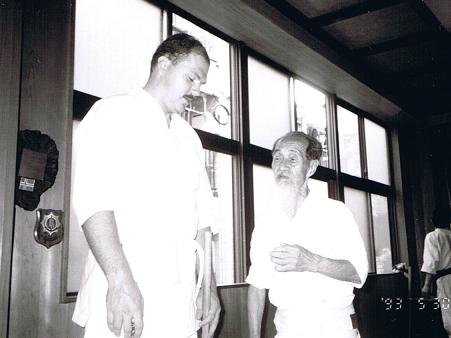 Life is about moments: Mr. Tong took this photo of Yoshio Sugino Sensei having a heart-to-heart talk with a visiting foreign student (Kawasaki 1993)
Life is about moments: Mr. Tong took this photo of Yoshio Sugino Sensei having a heart-to-heart talk with a visiting foreign student (Kawasaki 1993)
__________________________________________________
Guiding Philosophy
What philosophy guides Mr. Tong’s practice?
It can be encapsulated in the photo below:
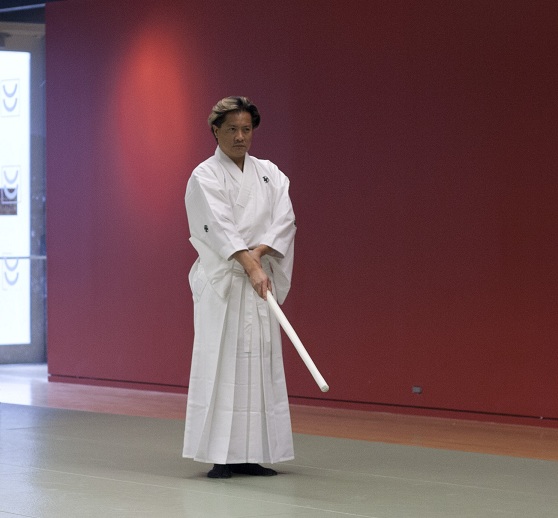
* Mr. Tong is pictured here in “mu-gamae” (literally “no-stance” or “empty stance”), the stance of no-stance. The quintessential stance of Yagyu Shinkage Ryu, it is a stance and not a stance; a paradox. It is a mindset and a principle. Emptiness is an important concept in Zen Buddhism, found in such famous Zen aphorisms as “munen muso” (no thought, no reflection). Breaking free from the bonds of limited action and limited thinking found in earlier styles of swordsmanship, epitomized by their heavy reliance on kamae (stances, positions), mugamae is true freedom: freedom of action, freedom from being fixed or stuck. A living sword, like a living animal, has freedom of action and freedom of purpose. We can move freely, spontaneously, flowing and adapting to the moment. Like the Zen Master Takuan Soho taught Yagyu Munenori, “it is like a ball in a swift-moving current: we respect the mind that flows on like this and does not stop for an instant in any place.” Mu-gamae is the perfect embodiment of the philosophy of Yagyu Shinkage Ryu, the consummate coalescense of thought and action.

